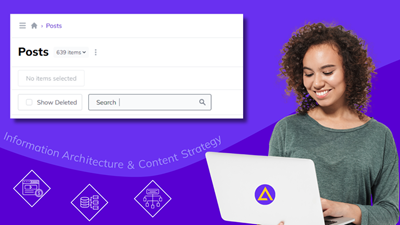How Information Architecture and Content Strategy Can Work Together


For most prospects, their buying journey is not linear.
They find information about the product they want to buy from online communities, comparison content, peer recommendations, social media, third-party reviews, and basic online searches.
A survey by Gartner reveals that only 24% of B2B buyers worked with sales reps to complete a purchase, compared to 65% who worked through the purchase process on their own.
By the time your prospect is landing on your website, they will be on different stages of their buying journey, and your content strategy will help you create content that your prospects need.
But that's not all.
You need to personalize your interactions with your prospects by organizing information on your website to help them find what they need. If you don’t, you’ll lose them for good.
A survey by Salesforce found that 62% of customers expect companies to anticipate and meet their needs across the buying journey.
In this case, once your prospects land on your website, they expect to find the information they need.
Information architecture will help you organize your content based on user needs and context to improve findability, and usability.
And when you combine information architecture and content strategy work together to deliver a great user experience by making it easy for users to find the content they need that helps them find answers to their questions.
In this article, you’ll learn more about content strategy and information architecture, how they are related and how they work together.
What is Content Strategy?
A content strategy is an ongoing plan that relies on content to achieve as the primary channel through which it will achieve business objectives.
Your content strategy determines the type of digital assets you’ll create, your content workflow, the tools you’ll use to collaborate, and every other element of your content operations.
Content strategy for SEO is a popular type of strategy that businesses create. It helps them increase the amount of organic traffic to their website to improve lead generation and, consequently, reduce overall customer acquisition costs.
However, you can also create a content strategy for customer success. Save time by using an AI tool to brainstorm content ideas that customers are interested in and create content that answers their questions post-purchase to improve retention.
The content you create for them, combined with the quality of customer support you provide will help them learn how to set up and use the product to meet their needs.
For example, having a knowledge base for customers and a community helps reduce the effort it takes for a customer to solve their issues, increasing the level of satisfaction and, consequently, loyalty.
What is Information Architecture?
As an art, information architecture involves structuring and presenting information to users to make it easy for them to find, use, and understand it.
As a science, information architecture involves understanding the user and the context behind their behaviour.
Information architecture relies on cognitive principles used in user experience design, such as proximity, continuity, and cognitive load, to structure information. It also depends on labelling, search bars, and navigation systems to organize information.
Both of these systems and principles help in eliminating data silos by simplifying complex information for your web visitors, turning your website into a meaningful structure with a useful navigation system that makes it easy for them to engage and complete their goals.
Information architecture and content architecture are often interchanged terms, but they don’t mean the same thing.
When talking about information architecture, you’re referring to how you can organize content and create categories to improve its findability.
You can also rely on the same organization to make it easy for search engines to crawl and index content by using a site map and labels.
On the other hand, content architecture focuses on how you structure content on your website by choosing what to publish, how you classify it, the labels you use and how you arrange it for easy comprehension.
Information Architecture vs Content Strategy: How are they related?
The relationship between information architecture and content strategy comes through providing a great user experience for your potential and existing customers.
Since information architecture is the design of how information is organized, it helps your website visitors find what they need quickly and easily.
It also involves structuring the navigation on your website so that users can access the information they need intuitively.
On the other hand, the content strategy helps you create content to meet users’ needs by guiding how you create, manage and deliver content to users on different channels.
While each of these disciplines might feel like they’re on opposing ends, information architecture and content strategy help you create a unified digital experience across different customer touchpoints, to help you achieve your business goals.
How Does Your Content Strategy And Information Architecture Work Together?
Your content strategy covers the content you’ve published, and information architecture affects how you organize and structure your content on your website.
As we mentioned earlier, information architecture seeks to understand the user and their context.
Understanding the user involves knowing who the user is (a prospect, a lead, or a customer), their needs, and their goals.
Understanding a user’s context involves looking into the reasons why and when a user is engaging with your content and what devices they use.
Understanding your users and the context behind their behaviour sheds light on how most users behave online:
Even if these users are looking for the same content on your website, they will use it differently to find the information they need.
When you combine your content strategy with information architecture, you consider a scalable structure for your website that allows your users to find the content they need.
If you’re publishing lots of content, a multipage structure is easy to scale because you can add multiple content types in relevant categories.
It's also easier to add internal links to help users find relevant content related to the topic you’re talking about, and it improves SEO rankings since search engines can crawl and index different types of content you publish.
When using information architecture, it doesn't matter where your web visitors land on your website to read the content you publish.
At a high level, most users won't land on your homepage when visiting your website. To make it easy for your web visitors to move around your website, you’ll need to implement the principle of front doors, which requires you to provide your web visitors with several access points for your site.
It won’t matter where they initially landed; they can still move around and find what they need. In addition to having content on different pages, information architecture helps you link relevant pages together to help visitors find what they need based on where they are on their buying journey.
For example, a pillar post, such as a video marketing guide, will need internal links to relevant subtopics, and comparison content might have a link to a product page. Each page, however, will need navigation links to help visitors move to any other page they want to after completing their goals.
Information architecture helps you publish structured content, to make it discoverable, save time during updates, and reduce production costs.
Unstructured content makes it difficult to create a cohesive narrative with your content and measure pointers to its effectiveness, such as dwell time, bounce rate and so on.
Besides, given that unstructured content is scattered in different places, you can’t find it whenever you want to update it, leading to duplication of efforts and an increase in the cost of content production.
On the other hand, your prospects can’t find the content they need on your website if it's unstructured, and search engines can't index it for discoverability in the SERPs.
When using information architecture and content strategy, you not only create content but also structure it in a way that is easy to find and understand.
Structured content also makes it easier for search engines to crawl and index the website, which can help improve the website's ranking on search engine results pages (SERPs).
Structured content also improves the user experience by providing visitors with a clear and organized navigation structure.
This allows them to easily find what they are looking for without having to wade through page after page of unstructured text.
Additionally, information architecture can help users navigate through complex websites. For example, complex websites can use labels for different categories that help in showing the user what content is behind the label, making it easier to understand your website.
Conclusion
As companies continue to recognize the need to use content to build an audience and generate leads, more content is going live, leading to information overload. For prospects, the most important thing is to find the content they need when they need it.
It's easy to feel like information architecture and content strategy are on two opposing ends, but they can work together to make your content strategy more effective and achieve your business goals.
When you blend content strategy and information architecture, you don’t just create content, publish it and hope that your visitors will find it. No more losing customers because they can’t find what they need. Every piece of content you publish can be found, and the visitor won’t have trouble finding it. Agility allows you to bring together information architecture and content strategy by helping you build a modern website page module to manage different content pages to make sure you have a consistent structure throughout your website.

About the Author
Agility CMS is Canada's original headless CMS platform. Since 2002, Agility has helped companies across Canada and around the world better manage their content. Marketers are free to create the content they want, when they want it. Developers are empowered to build what they want, how they want.
- Get a demo for a personalized walkthrough.
- Try for FREE and experience Agility CMS.
- Contact us with your questions.



